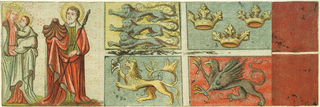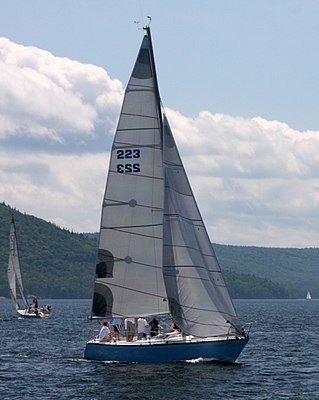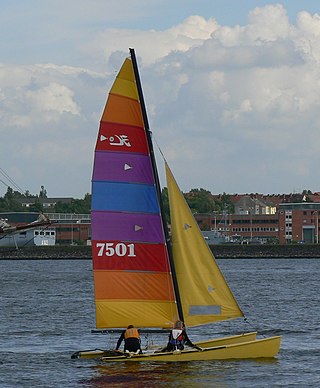Related Research Articles

A sailboat or sailing boat is a boat propelled partly or entirely by sails and is smaller than a sailing ship. Distinctions in what constitutes a sailing boat and ship vary by region and maritime culture.

In sailing, a halyard or halliard is a line (rope) that is used to hoist a ladder, sail, flag or yard. The term "halyard" derives from the Middle English halier, with the last syllable altered by association with the English unit of measure "yard". Halyards, like most other parts of the running rigging, were classically made of natural fibre like manila or hemp.

A traveller is a part of the rigging of a boat or ship that provides a moving attachment point for a rope, sail or yard to a fixed part of the vessel. It may take the form of anything from a simple ring on a metal bar or a spar to, especially in a modern yacht, a more complex "car" – a component with bearing-mounted wheels running on a shaped aluminium extrusion.

In sailing, a cunningham or cunningham's eye is a type of downhaul used on a Bermuda rigged sailboat to change the shape of a sail. It is named after its inventor, Briggs Cunningham, a victorious America's Cup skipper and yacht builder.

A maritime flag is a flag designated for use on ships, boats, and other watercraft. Naval flags are considered important at sea and the rules and regulations for the flying of flags are strictly enforced. The flag flown is related to the country of registration: so much so that the word "flag" is often used symbolically as a metonym for "country of registration".

A spinnaker is a sail designed specifically for sailing off the wind on courses between a reach to downwind. Spinnakers are constructed of lightweight fabric, usually nylon, and are often brightly colored. They may be designed to perform best as either a reaching or a running spinnaker, by the shaping of the panels and seams. They are attached at only three points and said to be flown.

Gunter rig is a configuration of sail and spars used in sailing. It is a fore and aft sail set abaft (behind) the mast. The lower half of the luff (front) of the sail is attached to the mast, and the upper half is fastened to a spar which is approximately vertical and reaches above the top of the mast. This spar is called a "yard", but it is common for some to confuse it with a "gaff". The overall shape of a gunter sail is roughly triangular, so having a superficial resemblance to Bermuda rig.

In sailing, a boom is a spar (pole), along the foot of a fore and aft rigged sail, that greatly improves control of the angle and shape of the sail. The primary action of the boom is to keep the foot flatter when the sail angle is away from the centerline of the boat. The boom also serves as an attachment point for more sophisticated control lines. Because of the improved sail control it is rare to find a non-headsail without a boom, but lateen sails, for instance, are loose-footed. In some modern applications, the sail is rolled up into the boom for storage or reefing.

The Tartan Ten, also called the Tartan 10, is an American sailboat that was designed by Sparkman & Stephens as a one-design racer and first built in 1978.

A fairlead is a device to guide a line, rope or cable around an object, out of the way or to stop it from moving laterally. Typically a fairlead will be a ring or hook.

The Banshee, sometimes called the Banshee 13, is an American sailing dinghy that was designed by Richard L. Reid as a one-design racer and first built in 1969.

Ljungström rig is the name for the sailing rig designed by Swedish engineer Fredrik Ljungström with double main sails and rotating mast, but without boom, foresail, forestay and shroud. The early models of the Ljungström sailboat had a stern stay but this was omitted around 1945, before the model 12.
The Ranger 23 is an American trailerable sailboat, that was designed by Gary Mull as an International Offshore Rule quarter-ton racer.

The lug sail, or lugsail, is a fore-and-aft, four-cornered sail that is suspended from a spar, called a yard. When raised, the sail area overlaps the mast. For "standing lug" rigs, the sail may remain on the same side of the mast on both the port and starboard tacks. For "dipping lug" rigs, the sail is lowered partially or totally to be brought around to the leeward side of the mast in order to optimize the efficiency of the sail on both tacks.

The Bluejacket 23 is a 23-foot (7.0 m) Canadian trailerable, fibreglass monohull sailboat designed by Cuthbertson & Cassian as a day sailer and club racer and first built in 1967.
The Seidelmann 245 is an American trailerable sailboat that was designed by Bob Seidelmann as a cruiser and first built in 1981. The designer was well known as a champion one design sailor and also as a sailmaker.
The Merit 25 is an American trailerable sailboat that was designed by Paul Yates as a Midget Ocean Racing Club (MORC) racer and first built in 1978.
The Pilot 35 is an American sailboat that was designed by Sparkman & Stephens as a racer-cruiser and first built in 1962.
The AMF Apollo 16 is an American sailing dinghy that was designed by Canadian Bruce Kirby as a one-design racer and first built in 1977.

The Hobie 18 is an American catamaran sailboat that was designed by Hobie Alter and Phil Edwards as a one design racer and first built in 1976.
References
- ↑ "OFF THE CHARTS: When Pigsticks Fly". Archived from the original on 2016-09-19. Retrieved 2023-08-12.
- ↑ "Pig-sticks and frigate birds". 24 March 2014.
- ↑ "Flag and Etiquette Committee".